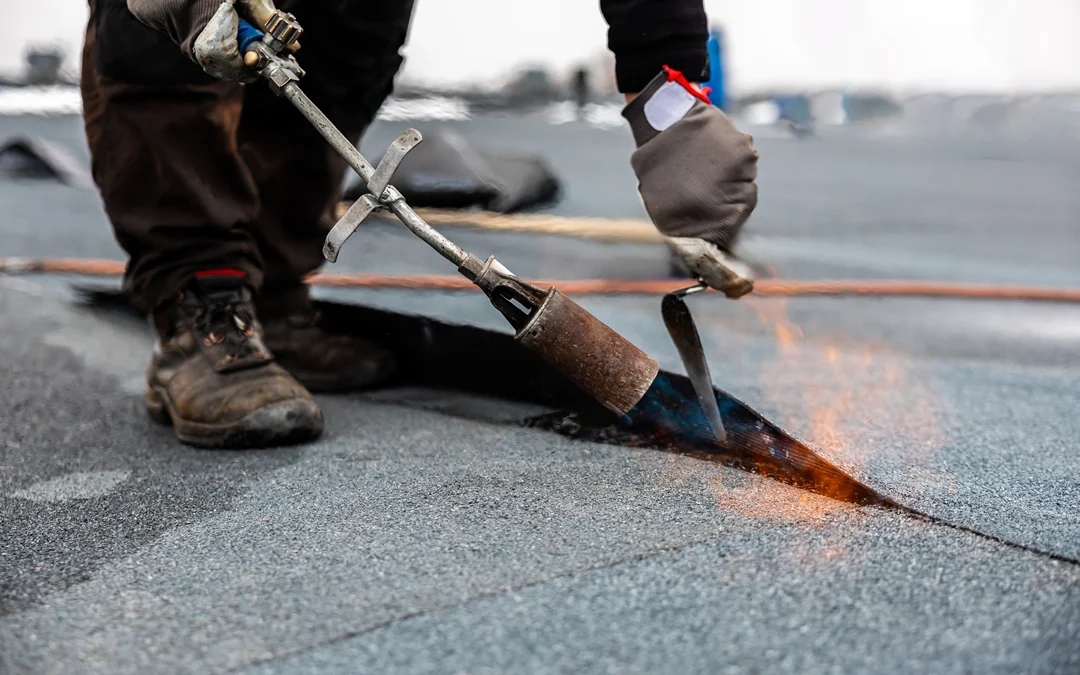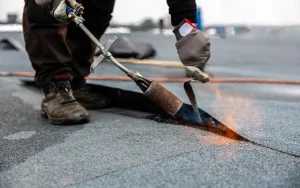When it comes to roofing, flat roofs are a popular choice for both commercial and residential buildings due to their modern aesthetic, ease of installation, and cost-effectiveness. However, despite their advantages, flat roofs can be prone to specific issues over time, especially if they need to be appropriately maintained. This article will explore the common problems associated with flat roofs and provide practical solutions for fixing them.
At ACE Pro Roof, we specialize in Flat Roof Repair and maintenance, ensuring that your roof remains durable and functional for years. Let’s dive into the most frequent flat roof problems and the steps you can take to address them.
Common Flat Roof Problems
1. Leaks
Leaks are arguably the most common and frustrating issue flat roof owners face. Water leaking into the building can cause significant damage to both the roof and the interior.
Causes of Leaks:
- Weathering and wear: Over time, exposure to the elements, such as sun, rain, and wind, can deteriorate the roof membrane, making it more prone to leaks.
- Poor installation or repairs: If the roof was not installed correctly or previous repairs were done improperly, compromised areas that allow water to seep in can result.
- Punctures and tears: Sharp objects, debris, or even foot traffic can puncture or tear the roof membrane, leading to leaks.
How to Fix It:
- Identify the leak: Start by locating the source of the leak. Inspect the roof for visible signs of damage or wear, such as cracks, holes, or blistering. Pay attention to areas around vents, chimneys, and seams where water might get in.
- Apply a patch: Apply a suitable roofing patch once the leak is identified. This can be done with a roofing sealant or a new piece of membrane that matches the existing material. If the damage is extensive, you may need to replace larger roof sections.
2. Ponding Water
Ponding water refers to water that accumulates in low spots on the roof due to improper drainage. Over time, standing water can cause the roofing material to weaken, leading to leaks, structural damage, and mould growth.
Causes of Ponding Water:
- Improper drainage system: Blocked or inadequate drainage systems are the main culprit behind ponding water.
- Roof slope issues: Flat roofs must be slightly sloped to encourage proper water runoff. If the slope is insufficient, water will pool in certain areas.
How to Fix It:
- Improve drainage: Install additional drains, scuppers, or gutters to ensure water is directed off the roof. For roofs with insufficient slopes, tapered insulation can create a gentle pitch for water to flow toward the drainage points.
- Clear debris: Regularly clean your roof of debris, such as leaves, branches, and dirt, which can clog drains and prevent proper water flow.
3. Cracked or Damaged Membranes
The membrane of a flat roof serves as the primary barrier between the building and the elements. Over time, these membranes can crack, split, or become damaged due to exposure to UV rays, temperature fluctuations, or physical damage.
Causes of Membrane Damage:
- Sun exposure: UV rays can degrade roofing materials, causing them to become brittle and crack.
- Physical damage: Hail, fallen branches, or heavy foot traffic can damage the membrane.
- Improper installation: Incorrectly applied seams or materials can lead to early membrane failure.
How to Fix It:
- Assess the damage by inspecting the membrane for visible cracks, holes, or blisters. You can apply a roofing sealant or patch the damaged area with a matching piece of membrane for small cracks.
- Replace damaged sections: If the damage is extensive or widespread, it may be necessary to replace entire sections of the roof membrane. Work with a professional roofing contractor to install the new material correctly.
4. Blisters or Bubbles in the Roof Surface
Blisters or bubbles can form on the surface of a flat roof due to trapped moisture beneath the membrane. When the moisture evaporates, it creates a pocket of air, which causes the roof material to bubble up.
Causes of Blisters:
- Moisture under the membrane: Moisture can get trapped during installation or due to condensation.
- Improper ventilation: Poor ventilation in the attic or under the roof can increase the likelihood of moisture buildup.
How to Fix It:
- Puncture and drain the blister: If you notice a blister or bubble on your roof, puncture it to release the trapped moisture. After draining the bubble, apply a patch to seal the hole.
- Ventilation improvements: Ensure proper ventilation to reduce the amount of moisture accumulating under the roof. Adding venting systems or insulation in the attic can help prevent future blisters.
5. Shrinkage and Cracking
Flat roof materials like rubber or plastic membranes can shrink over time due to extreme temperature changes, leading to cracks and gaps. This can compromise the roof’s ability to shed water and create leaks.
Causes of Shrinkage:
- Temperature fluctuations: The expansion and contraction of materials due to heat and cold can cause the roof to shrink and crack.
- Aging materials: As roofing materials age, they become less flexible and more prone to shrinkage.
How to Fix It:
- Seal the cracks: Use a high-quality roofing sealant to fill any cracks or gaps in the membrane.
- Replace the affected section: If the shrinkage or cracking is extensive, replacing the damaged sections of the roof may be necessary.
6. Poor Installation or Repairs
If a flat roof is installed or previous repairs are done correctly, the roof will likely experience issues over time.
Causes of Poor Installation:
- Unqualified contractors: Hiring an inexperienced or unqualified roofing contractor can result in subpar installation.
- Wrong materials: Using the wrong roofing materials for the specific climate or building type can lead to premature failure.
How to Fix It:
- Hire a professional: If you suspect your roof was improperly installed or repaired, it is essential to hire a professional roofer to assess the situation and make necessary corrections.
When to Call a Professional
While DIY repairs can be effective for minor issues, some flat roof problems require the expertise of a professional. If you’re dealing with large-scale damage, structural issues, or complex repairs, it’s best to consult a roofing contractor. Here’s when you should call the professionals:
- Extensive damage or widespread leaks
- Damage to the structural components of the roof
- Issues beyond your expertise or Comfort level
- If you’ve noticed recurring problems that DIY fixes haven’t addressed
Conclusion
Proper maintenance and timely repairs can extend the life of a flat roof for many years. By being proactive in identifying and addressing common problems like leaks, ponding water, damaged membranes, and blisters, you can avoid costly repairs. Regular inspections and maintenance are key to ensuring that your flat roof remains in optimal condition.
At ACE Pro Roof, we are committed to providing expert Flat Roof Repair Services tailored to meet your building’s unique needs. Our experienced team is here to help with everything from minor repairs to full roof replacements. Contact us today to schedule an inspection and keep your flat roof in top shape!
FAQs About Flat Roof Repair
1. How often should I inspect my flat roof? Inspecting your flat roof at least twice a year—once in the spring and once in the fall is recommended. Additionally, inspect the roof after severe weather events such as heavy rain, snow, or high winds.
2. Can I repair my flat roof myself? Minor repairs, such as patching small leaks or applying sealant, can often be done as a DIY project. However, for more significant issues or complex maintenance, it is best to hire a professional to ensure the repair is done correctly.
3. How long do flat roofs last? The lifespan of a flat roof depends on the materials used, the installation quality, and the maintenance level. On average, it can last between 15 and 30 years.
4. What causes a flat roof to leak? Flat roof leaks can be caused by poor installation, aging roofing materials, punctures, cracks, or issues with the drainage system. Regular maintenance can help prevent leaks from occurring.
5. How can I prevent ponding water on my flat roof? To prevent ponding water, ensure your roof has a proper slope and install a sufficient drainage system with drains, scuppers, or gutters. Regular cleaning is also essential to prevent debris buildup.

